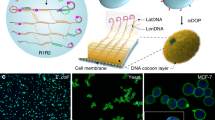Abstract
Animal cell technology is attracting considerable interest because of the capacity of animal cell cultures to synthesize or transform complex compounds such as virus vaccines, immunochemicals, hormones or enzymes1. For the growth of surface-dependent cells, microcarrier technology is gaining importance2. Here, we have attempted to immobilize surface-independent cells, normally grown in suspension, by entrapping them in polymer microbeads. Such entrapment should give increased stability to the normally fragile animal cells, allow for high cell densities to be achieved within the beads and make such preparations suitable for continuous operation. At the same time, the need for separation of the desired product from the cells is obviated. With the model systems studied, we showed that hybridoma, as well as other cell lines entrapped in agarose microbeads, remained viable. Both immunoglobulins and lym-phokines were exported through the microbeads into the medium for 1–3 weeks, at levels corresponding well to those produced with free cells.
This is a preview of subscription content, access via your institution
Access options
Subscribe to this journal
Receive 51 print issues and online access
$199.00 per year
only $3.90 per issue
Buy this article
- Purchase on Springer Link
- Instant access to full article PDF
Prices may be subject to local taxes which are calculated during checkout
Similar content being viewed by others
References
Spier, R. E. J. Chem. Technol. Biotechnol. 32, 304–312 (1982).
van Wezel, A. L. Nature 216, 64–65 (1967).
Nilsson, K. & Mosbach, K. FEBS Lett. 118, 145–150 (1980).
Lim, F. & Sun, A. M. Science 210, 908–910 (1980).
Nilsson, K. & Mosbach, K. Swedish patent application no. 8210041-0.
Nilsson, H., Mosbach, R. & Mosbach, K. Biochim. biophys. Acta 269, 253–256 (1972).
Rabin, H. et al. Immunology 127, 1852–1856 (1981).
Scheirer, W. & Krömer, E. Dev. biol. Standards (in the press).
Author information
Authors and Affiliations
Rights and permissions
About this article
Cite this article
Nilsson, K., Scheirer, W., Merten, O. et al. Entrapment of animal cells for production of monoclonal antibodies and other biomolecules. Nature 302, 629–630 (1983). https://doi.org/10.1038/302629a0
Received:
Accepted:
Issue Date:
DOI: https://doi.org/10.1038/302629a0
This article is cited by
-
Hyaluronic acid/mildly crosslinked alginate hydrogel as an injectable tissue adhesion barrier
Journal of Materials Science: Materials in Medicine (2012)
-
Hybridoma cells in a protein-free medium within a composite gel perfusion bioreactor
Cytotechnology (1994)
-
High-density culture of FM-3A cells using a bioreactor with an external tangential-flow filtration device
Cytotechnology (1994)
-
The determination of cellular viability of hybridoma cells in microtitre plates: A colorimetric assay based on neutral red
Cytotechnology (1993)
Comments
By submitting a comment you agree to abide by our Terms and Community Guidelines. If you find something abusive or that does not comply with our terms or guidelines please flag it as inappropriate.



